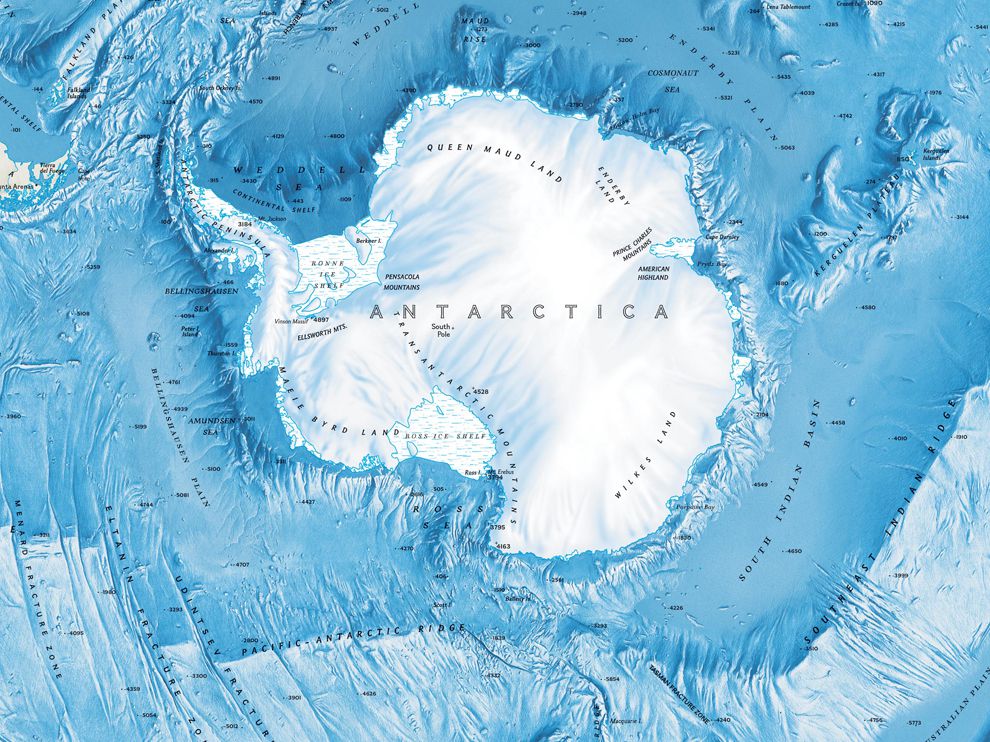
- 357 Lê Hồng Phong, P.2, Q.10, TP.HCM
- Hotline 1: 1900 7060
Hotline 2: (028) 3622 8849
Bài tập IELTS Reading - The Geography of Antarctica - Phân tích từ vựng
The Geography of Antarctica

The continent of Antarctica makes up most of the Antarctic region. The Antarctic is a cold, remote area in the Southern Hemisphere encompassed by the Antarctic Convergence, an uneven line of latitude where cold, northward-flowing Antarctic waters meet the warmer waters of the world’s oceans. The whole Antarctic region covers approximately 20 percent of the Southern Hemisphere. Antarctica is the fifth-largest continent in terms of total area, larger than both Oceania and Europe. It is unique in that it does not have a native population. There are no countries in Antarctica, although seven nations claim different parts of it: New Zealand, Australia, France, Norway, the United Kingdom, Chile, and Argentina.
The Antarctic Ice Sheet dominates the region. It is the single piece of ice on Earth covering the greatest area. This ice sheet even extends beyond the continent when snow and ice are at their most extreme. The ice surface dramatically expands from about 3 million square kilometers (1.2 million square miles) at the end of summer to about 19 million square kilometers (7.3 million square miles) by winter. Ice sheet growth mainly occurs at the coastal ice shelves, primarily the Ross Ice Shelf and the Ronne Ice Shelf. Ice shelves are floating sheets of ice that are connected to the continent. Glacial ice moves from the continent’s interior to these lower-elevation ice shelves at rates of 10 to 1,000 meters (33-32,808 feet) per year.
Antarctica has numerous mountain summits, including the Transantarctic Mountains, which divide the continent into eastern and western regions. A few of these summits reach altitudes of more than 4,500 meters (14,764 feet). The elevation of the Antarctic Ice Sheet itself is about 2,000 meters (6,562 feet) and reaches 4,000 meters (13,123 feet) above sea level near the center of the continent.
Without any ice, the continent would emerge as two distinct areas: a giant peninsula and archipelago of mountainous islands, known as Lesser Antarctica, and a single large landmass about the size of Australia, known as Greater Antarctica. These regions have different geologies; Greater Antarctica, or East Antarctica, is composed of older, igneous rocks whereas Lesser Antarctica, or West Antarctica, is made up of younger, volcanic rock. Lesser Antarctica, in fact, is part of the “Ring of Fire,” a tectonically active area around the Pacific Ocean. Tectonic activity is the interaction of plates on Earth’s crust, often resulting in earthquakes and volcanoes. Mount Erebus, located on Antarctica’s Ross Island, is the southernmost active volcano on Earth.
Antarctica has an extremely cold, dry climate. Winter temperatures along Antarctica’s coast generally range from -10° Celsius to -30° Celsius (14° Fahrenheit to -22° Fahrenheit). During the summer, coastal areas hover around 0°C (32°F) but can reach temperatures as high as 9°C (48°F). In the mountainous, interior regions, temperatures are much colder, dropping below -60°C (-76°F) in winter and -20°C (-4°F) in summer. In 1983, Russia’s Vostok Research Station measured the coldest temperature ever recorded on Earth: -89.2°C (-128.6°F). An even lower temperature was measured using satellite data taken in 2010: -93.2°C (-135.8°F)
Precipitation in the Antarctic is hard to measure. It always falls as snow. Antarctica’s interior is believed to receive only 50 to 100 millimeters (2-4 inches) of water (in the form of snow) every year. The Antarctic desert is one of the driest deserts in the world. The oceans surrounding Antarctica provide an important physical component of the Antarctic region. The waters surrounding Antarctica are relatively deep, reaching 4,000 to 5,000 meters (13,123 to 16,404 feet) in depth.
The Antarctic region has an important role in global climate processes. It is an integral part of the Earth’s heat balance. This balance, also called the energy balance, is the relationship between the amount of solar heat absorbed by Earth’s atmosphere and the amount deflected back into space. Antarctica has a larger role than most continents in maintaining Earth’s heat balance and ice is more reflective than land or water surfaces. As a result, the massive Antarctic Ice Sheet reflects a large amount of solar radiation away from Earth’s surface. As global ice cover (ice sheets and glaciers) decreases, the reflectivity of Earth’s surface also diminishes. This allows more incoming solar radiation to be absorbed by the Earth’s surface, causing an unequal heat balance linked to global warming, the current period of climate change.
Interestingly, NASA scientists have found that climate change has caused more ice to form in some parts of Antarctica. They say this is happening because of new climate patterns caused by this change, which in turn create a strong wind pattern called the ‘polar vortex.’ These kinds of polar winds lower temperatures in the Antarctic and have been building in strength in recent decades—as much as 15 percent since 1980. This effect is not seen throughout the Antarctic, however, and some parts are experiencing ice melt.
Answer the questions below.
Choose NO MORE THAN TWO WORDS from the passage for each answer.
Write your answers in boxes 14-17 on your answer sheet.
Antarctica’s location far from other continents means that it is very 14……………………….
Antarctica is alone among the continents in having no 15………………………
The Antarctic ice sheet holds the record as the largest 16……………………. ice sheet on Earth.
17……………………… are blocks of ice connected to the Antarctic ice sheet.
Do the following statements agree with the information given in the passage on the previous page?
In boxes 18–21 on your answer sheet, write
TRUE if the statement agrees with the information
FALSE if the statement contradicts the information
NOT GIVEN if there is no information on this
18 Some of Antarctica’s mountains are popular with climbers.
19 The temperature in Antarctica never rises above 0°C.
20 Antarctica constitutes around one-fifth of the southern half of the world.
21 Rain in Antarctica is rare but falls occasionally.
Complete the summary using the list of words, A-G, below.
Write the correct letter, A-G, in boxes 22-26 on your answer sheet.
Antarctica plays an important role in regulating the Earth’s climate through the process of 22…………………… 23……………………… is diverted away from the Earth by the huge Antarctic ice sheet. As the size and 24……………………… of the ice sheet have decreased, 25…………………….. has caused melting in some parts of the continent. However, other areas of Antarctica have experienced falling temperatures in recent years, due to 26…………………….., climate patterns leading to reduced temperatures.
A reflectivity B ice melt C solar radiation
D polar vortex winds E heat balance F water surfaces
G global warming
PHÂN TÍCH TỪ VỰNG:
Encompassed by: bao quanh bởi
Line of latitude: đường vi độ
The coastal ice shelves: thềm băng ở bờ biển
The continent’s interior: bên trong của lục địa
Lower-elevation: độ cao thấp
Mountain summits: đỉnh núi
Reach altitudes: đạt tới độ cao
A giant peninsula: bán đảo khổng lồ
Igneous rocks: đá hóa thạch
Ring of fire: vành đai núi lửa
An integral part: phần không thể thiếu
Deflected back into space: lượng bị phản chiếu vào không gian
Linked to global warming: dẫn tới việc nóng lên toàn cầu
Polar vortex: lốc xoáy vùng cực
Answer key
14. remote 15. native population 16. single 17. ice shelves
18. NOT GIVEN 19. FALSE 20. TRUE 21. FALSE
22. E 23. C 24. A 25. G 26. D
THƯ VIỆN LIÊN QUAN

Reading là một trong bốn phần thi bắt buộc của bài thi IELTS, đây cũng được xem là phần thi thử thách nhất để chinh phục được band điểm cao. Hãy...

Bài viết cung cấp cho đọc giả Bài tập Reading part 3 - Chủ đề: Why fairy tales are really scary tales - Có đáp án

Bài viết cung cấp cho đọc giả Bài tập Reading part 2 - Chủ đề: The Desolenator: producing clean water - Có đáp án

Bài viết cung cấp cho đọc giả Bài tập Reading part 1 - Chủ đề: Henry Moore (1898-1986) - Có đáp án
Hoặc gọi ngay cho chúng tôi:
1900 7060
 | Chính sách bảo mật thông tin | Hình thức thanh toán | Quy định chung
| Chính sách bảo mật thông tin | Hình thức thanh toán | Quy định chung
Giấy chứng nhận đăng ký doanh nghiệp số 0310635296 do Sở Kế hoạch và Đầu tư TPHCM cấp.
Giấy Phép hoạt động trung tâm ngoại ngữ số 3068/QĐ-GDĐT-TC do Sở Giáo Dục và Đào Tạo TPHCM cấp